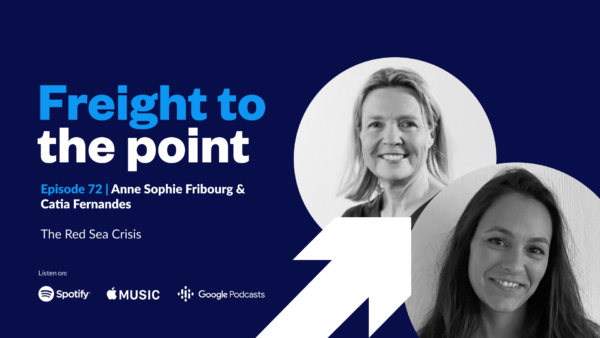Episode 32:
Zencargo's December Ocean Update
See all episodes

“We don’t anticipate any shocks on the demand side coming into December. Whilst Black Friday is a peak period, and the run-up to Christmas, we do think that businesses will be running through existing stock until the new year”
Are you up to date with the latest ocean freight market news? Are you prepared for the month ahead, especially as we head into 2023?
In the latest episode of Freight to the Point, Marina Lennie and Richard Fattal sit down to explore what has happened in the last month and how it has affected the market.
We’ll be exploring:
- Continued announcements of blank sailings throughout November
- Port decongestion in the US
- What could happen to demand levels before Chinese New Year
- How shippers should approach their budgets when entering 2023
Marina Lennie
Marina Lennie is the Director of Ocean Growth at Zencargo. Marina has over 20 years of experience in the shipping space, having worked at MSC for over 10 years. She now leads the pricing team at Zencargo, and is responsible for the company’s pricing processes and strategy.
Richard Fattal
Richard Fattal is Co-Founder and Chief Commercial Officer of Zencargo, the digital freight forwarder enabling organisations to make smarter decisions through real-time data of their supply chain. Based in London, Zencargo helps customers manage their supply chain such as Swoon Furniture and Ribble Cycles.
Resources
 |
Hi, and welcome to another episode of Freight to the Point. I’m Marina Lennie, Zencargo’s Director of Ocean Growth, and today we’ve invited Richard Fattal back on again to talk about what’s happening in the ocean market, how it’s affected rates, and some of his predictions for the coming months. Hi, Richard. |
|
Hi, Marina. Thanks so much for having me back on.
|
 |
 |
So, Richard’s been working really closely with customers at Zencargo to get the best rates and transit times, as well as providing bespoke consultations. In the previous episodes we talked about how the blank sailings post Golden Week weren’t enough to send the decline and rates and how Golden Week has lost its shine due to low demand during this peak season, why shippers should not be reckless and rush into any decisions. We have seen a lot of shippers skeptical, but then also those looking about for, I wouldn’t say deals, but anything with a bit more safety in it. So what things have happened in the last month, Richard, that you can tell us about that have affected the market as we look back into what happened in November? |
|
For sure, I mean, during the month of November we had further publication of container trade statistics. So the September numbers for trade into Europe out of Asia, trade into the US, were down 25% and 20% respectively. And October was even worse than the September numbers. And so effectively the lack of demand that we’ve seen at origin is being translated into a real reduction in the arrival of containers into ports in Europe and the US. And we’re now in a situation where we’ve seen most of the port congestion in both Europe and the US come out of the system. I think for the first time Long Beach, from a poor congestion perspective, is back to normal pre COVID conditions. And so you can anticipate a lead time on that lane, which is more normalised.
Of course, that’s good news for shippers, good news for shippers planning their journey across the Pacific, good news for shippers planning their journey through the sewer and over to Europe in terms of being able to anticipate a reduced lead time. But it also means that there’s a reduction in congestion through the market, which actually translates into an increase in effective capacity as well. So not only do you have a reduction in cargo being shipped because of reduced demand in the end markets in Europe and the US, and the same destocking trend that we talked about last time where European and US corporates are working through their stocks where they’ve been overstocked over the last few months, but you also have an effective increase in capacity because container ships are no longer stuck waiting at ports. They’re able to turn in a more reasonable timetable and therefore are able to get back to Asia quicker and be ready to take on more cargo.
So that trend has very much continued over the last month and that’s meant downward pressure on rates on both the Asia Europe trades and on the transpacific trade. Against that, carriers have been looking to reduce capacity, but they haven’t been reducing capacity at the same rate as the reduction in demand in the market that we’ve seen. So whilst we did see continued announcements of blank sailings throughout the November period, the net impact still has not meant a reduction in overall effective capacity.
|
 |
 |
So I guess that’s been a long time coming for shippers to finally see a bit of decongestion happening around LA Long Beach. I bet you there are lots of happy people in that front. Long may at last. On the capacity front, yeah, a hundred percent. And that comes at the same time, so more capacity not only from the decongestion but also from carriers putting in new vessels onto new trades due to the new IMO regulations. So yes, they’re trying to reduce the amount of capacity to keep their rates under control but at the same time are faced with this IMO challenge.So anyway, quite a few great insights there, thanks for that. And so as we look forward, on the other hand, what do you think December has to hold for us. Is there any insights that you could share? |
|
So whilst we’ve been talking about dramatic declines in rates since the end of the summer, we are now starting to see reductions in the pace of the decline. And this actually makes a lot of sense, because rate levels are now almost in line with 2019 levels, and over the last couple of years we’ve seen carrier costs increase across the cost of fuel, their need to comply with IMO regulation, and the cost of the port fees and other fees that the carriers have to pay in order to run their vessels. And therefore, as rates come down closer to in line with marginal cost and in some cases below marginal cost, we do anticipate the pace of decline really, really starting to come down. That said, we don’t anticipate any shocks on the demand side coming into December. Businesses in Europe and the US are still working through stock, and whilst Black Friday is a peak period, and the run-up to Christmas, we do think that businesses will be running through existing stock until the new year.
I think the big question is what happens after December. And what we have seen, which I would say is a little bit of a green shoot amongst a lot of dreary and negative news across the board, is two things. The first thing is that cost push inflation. So that’s things like fuel, food prices, energy prices across the board, have started to come down. And so oil price as an example, is really very much come down to levels not seen since the beginning part of 2022. And away from that, we are seeing some other measures of inflation also come down. And I think those are positive signs for the consumer in 2023.
The other thing that I would say is that we have seen some early data on Black Friday here in Europe, and things don’t look as bad as all that. So we’ve seen some data out of Bucket card for example, who run the transaction levels in the UK, and they’re up here on year on last year. So whilst there are a lot of reports of businesses still working through too much stock, particularly in the apparel space, we do think that the Black Friday period and the holiday period is going to be perhaps less of a disaster than some have reported.
And so what that means in reality is that we’re still very much going through this destocking phase, this phase where businesses have been broadly overstocked since the end of the summer, and they’re working through those stock levels, but that we don’t have a lot of transparency on the other side of Chinese New Year. So the big watch-out for me is what happens to demand levels the other side of Chinese New Year, which opens up a little bit of the question, what should customers start to think about going into the end of the year and as they start to think about a contract negotiation right now?
|
 |
 |
A hundred percent. And so with all those insights that you have touched upon, so that increased capacity, the decreased congestion, this demand that is lower but you’re saying that there is a form of optimism around there, what can shippers look for? How would you suggest that they look at their rate strategy going into that period? |
|
So that’s a good question, Marina. So what next? What should shippers be thinking about doing? How should they think about contracting going into 2023? I mean, that’s the million-dollar question, and that’s the conversation that I’m having with customers all the time right now. And what I would say is that the number one call out, the number one watch out for customers, is look at your budgets and look at the budget that you are likely to be making for 2023 and compare that to the budget for 2022. When you talk about freight spend, when you talk about cost of goods sold, we’re looking at freight rates on Asia, Europe, Trans-Pacific that are down three, four, five, six times depending on where you contracted last year compared to the peak of the market. And so shippers should really be thinking about how can I make sure that my business is benefiting from these reduced cost of good sold, and how can I have some stability going into 2023?
Now whilst, you might say, look, 2023, 2024, these are years that are really characterised by more supply coming into the market, more ships, bigger ships, the larger shippers bringing on more and more capacity. What you can say on the other side is there are some unknowns. Number one is the IMO regulations that are coming into the market, which may have an impact in capacity coming out. But number two, you are now talking about rate levels that are getting down towards the marginal cost of production for the shipping lines. And so it starts to look very interesting to contract for longer.
The big question becomes, how do you have security of service, service levels and an effective and secure supply chain in an environment where shipping lines might be taking out capacity in certain weeks in order to make sure that they have the right level of supply and demand?And I think that’s where a balanced strategy and a balanced approach to a supply chain comes in. So I would say shippers, especially larger shippers, should be looking to have a, let’s say, core carrier strategy for 2023, where they really do have fixed capacity on their core stable volumes. And then they should also make sure that they have some other options for those weeks and those periods during the year where the capacity might come out of the market, and where there might be less certainty around service levels, whilst this year some of the newer products like index linked contracts might have made more sense. I think actually being able to secure a long term contract for next year does make a lot of sense.
|
 |
 |
So what I hear you saying is that despite this lower level of rates in general, because carriers are all reaching that same bracket of rate level, and as you say very close to their cost to provide, you’re saying diversified rate strategy is still the way to go and this time it will be more on diversified carrier strategy as opposed to a rate differentiation and that customers can start looking again for service levels, transit times, and other such, rather than just the number of freight, which will be really refreshing for shippers who have been so rate driven over the past year, nearly two. |
|
I think that makes a lot of sense, Marina. I think what’s been interesting over the past few months also, is that carriers had different strategies and there’s been quite a lot of dislocation in the market because some of the carriers on the back of those different strategies that they’ve had, have had more and less capacity in the market. I think as we start to get into a reset in 2023, especially with more capacity coming into the market, there are more options for shippers. And so I think it will make sense depending on the lane that you are on, the port pairs that you are operating on to have a core carrier strategy, and yes, to make sure you have some diversity in terms of some additional carrier support and potentially some additional spot market support just to give that flexibility for last minute increases in production.
I would also say that a lot of shippers are unsure of their forecast for 2023, and that’s something that we’re engaged actively with customers in trying to help them to understand. But I would try to make sure that the part of your forecast that you are more sure about, that you do lock in capacity for 2023, and that you benefit from some of the lower levels available in the market right now whilst making sure that you are planning ahead for how your business might change going into an uncertain environment for next year.
|
 |
 |
So definitely it’s become more of an upper hand now for shippers, but I do hear an air of caution as to remaining agile being somewhat key.
|
|
A hundred percent, Marina, and we cannot forget to remain agile. And what I would say is, and it’s something I’ve said before on this program, is whilst next year is not going to be like this year, and we do need to reframe the way that we’re thinking for a new environment, for an environment with more capacity and one that favors shippers in the negotiating room, we cannot forget the lessons of the last two years and the constraints that businesses have had in their supply chains. And we only have to look at the last few days in terms of the news in the market out of China and the potential disruption that could cause in the market, to really think about contingencies that businesses need to have in place in their supply chain.
So I would say that whilst thinking about contracting for the new year, what’s really important is to understand both the rate level but also the potential service level, the strategies of the carriers and the level of diversification that you need in your supply chain to support any potential disruption for next year. And I would encourage all shippers to engage in an active dialogue with their service provider around options, but also around contingencies if things change rapidly.
|
 |
 |
And also to look into those forecasting elements and to try and get that as close to the mark as possible.
|
|
Yes, a hundred percent, Marina. And I would also say that forecasting is going to become even more key for 2023. I think while 2022 it was just sort of anyone’s guess what you had to ship and whether you were going to get capacity, it’s now become very much front and center, front of mind, for carriers to make sure that they have reliable partners to fill their ships for 2023, 24 and beyond. And so, at the extent to which you can work with your forwarder, with your carrier partner to be able to forecast your volumes, can only give you the upper hand in that relationship and put you into a strong position when it comes to securing stability in your supply chain.
|
 |
 |
So definitely better looking times ahead for the shippers of this world. And on that optimistic note, thanks Richard so much for your time, and thanks for everyone who was listening. Thanks again to all our listeners for tuning into this episode of Freight to the Point. Don’t forget to like and subscribe to our show. And if you have any feedback on this episode, please don’t hesitate to reach out on LinkedIn or anywhere else. Until the next episode, bye. |

Episode 72: The Red Sea Crisis
In the latest episode of Freight to the Point, we’ve featured our most rec...

Episode 71: The potential of demand forecasting with artificial intelligence
In the most recent instalment of Freight to the Point, Lucie Phillips, Zen...

Episode 70: Rates: What's next for 2024?
As we prepare for the year ahead, it's crucial to consider the three pillars...

